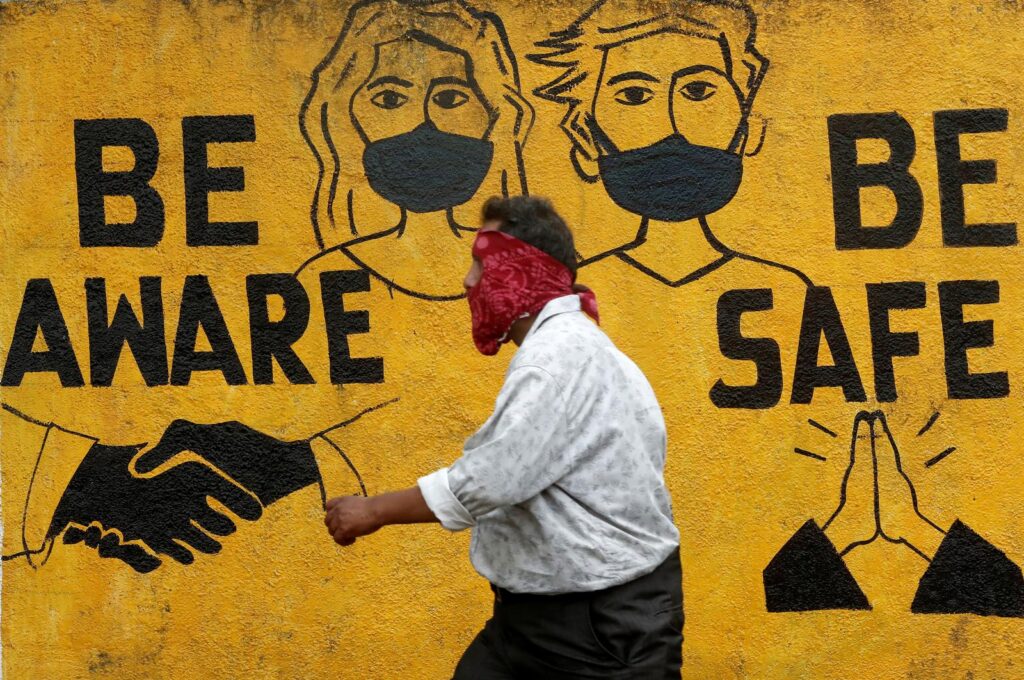Features Making Someone Virus Super-Spreader Identified
Nov 21, 2020 | Pratirodh Bureau
FILE PHOTO: A man walks past graffiti amid the spread of the coronavirus disease in Mumbai
Using computer-generated models, scientists have simulated sneezes in different types of people, and identified the biological features that could make a person super-spreader of viruses such as the novel coronavirus which causes Covid-19.
The study, published in the journal Physics of Fluids, determined associations between people’s physiological features and how far their sneeze droplets travel and linger in the air.
According to the scientists, including those from the University of Central Florida (UCF) in the US, people’s features, like a stopped-up nose, or a full set of teeth, could increase their potential to spread viruses by affecting how far droplets travel when they sneeze.
The US Centers for Disease Control and Prevention had earlier noted that the main way people are infected by the novel coronavirus is through exposure to respiratory droplets, such as from sneezes and coughs that are carrying infectious virus.
Knowing more about factors affecting how far these droplets travel can inform efforts to control their spread, said study co-author Michael Kinzel from UCF.
“This is the first study that aims to understand the underlying ‘why’ of how far sneezes travel,” Kinzel said. “We show that the human body has influencers, such as a complex duct system associated with the nasal flow that actually disrupts the jet from your mouth and prevents it from dispersing droplets (over) far distances,” he added.
Citing an example, the researchers said when people have a clear nose, such as from blowing it into a tissue, the speed and distance sneeze droplets travel decrease.
This is because a clear nose provides a path in addition to the mouth for the sneeze to exit, they added. However, when people’s noses are congested, the area that the sneeze can exit is restricted, thus causing sneeze droplets expelled from the mouth to increase in velocity, the study noted.
According to the scientists, the teeth also restrict the sneeze’s exit area and cause droplets to increase in velocity.
“Teeth create a narrowing effect in the jet that makes it stronger and more turbulent,” Kinzel said. “They actually appear to drive transmission. So, if you see someone without teeth, you can actually expect a weaker jet from the sneeze from them,” he added.
In the research, the scientists used 3D modeling and numerical simulations to recreate four mouth and nose types — a person with teeth and a clear nose, a person with no teeth and a clear nose, a person with no teeth and a congested nose, and a person with teeth and a congested nose.
When they simulated sneezes in the different models, they found that the spray distance of droplets expelled when a person has a congested nose and a full set of teeth is about 60 per cent greater than when they do not.
The findings revealed that when someone keeps their nose clear, such as by blowing it into a tissue, they could be reducing the distance their germs travel.
The researchers also simulated three types of saliva — thin, medium and thick.
They found that thinner saliva resulted in sneezes composed of smaller droplets, which created a spray and stayed in the air longer than medium and thick saliva.
The findings yield novel insight into variability of exposure distance and indicate how physiological factors affect transmissibility rates, said Kareem Ahmed, another co-author of the study from UCF.
“The results show exposure levels are highly dependent on the fluid dynamics that can vary depending on several human features,” Ahmed said. “Such features may be underlying factors driving superspreading events in the Covid-19 pandemic,” he added.
